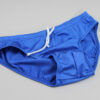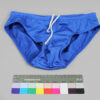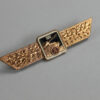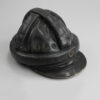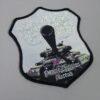Bundeswehr swimming trunks
Inventory number: DPM 1.898
Every soldier in the Bundeswehr should be able to swim. In general basic training, the swimming ability of applicants is tested regardless of the branch of the armed forces and deployment. As in the civilian sector, this is of course to prevent drowning; in military terms, swimming serves to ensure that bodies of water can be crossed without aids. In service sports, however, swimming was primarily part of the general sports program for decades, helping to promote health, relaxation and physical balance in everyday service life. Over the past 20 years, the Bundeswehr has once again placed greater emphasis on the benefits of sport for combat operations, which has led to a softening of the previously enforced separation of combat training and sporting activities. As early as 2007, Brigadier General Weisenburger, then head of the “Armed Forces Training” department, saw sport as an essential part of “making Bundeswehr soldiers physically and mentally fit for deployment at home and abroad”.
A formalization of the sporting activities of soldiers beyond drill can only be established in 1926 with the sports regulations of the Reichswehr. Sports training was now “service” and included gymnastics, apparatus gymnastics, athletics, games and hand-to-hand combat in addition to swimming. The ability to swim was also career-relevant in the Reichswehr: In order to take the NCO or Fahnenjunker examination, the ability to swim freely had to be proven. In the Wehrmacht, this requirement for promotion was dropped and swimming was only used to enable soldiers to overcome “water obstacles”. Overall, sport in the Wehrmacht was given a high ideological significance and a stronger focus was placed on the “education of the soldier as a combatant ready for action”, whereas in the Reichswehr, sport was primarily used as a health-promoting counterbalance.
In a press conference prior to the publication of the first service regulation on sport in the Bundeswehr in 1963, the then Federal Minister of Defense Kai-Uwe von Hassel said: “Sport in the Bundeswehr should be filled with the spirit and life of a modern sports movement: it should not be mixed with military exercises.” However, the phrase “Sport awakens and strengthens the sense and feeling for manliness, comradeship and chivalry” as one of the guiding principles of the service regulations shows the focus on the educational function of sport and is still strongly reminiscent of the language of the Wehrmacht.
The Bundeswehr’s first sports kit in 1956 was also very similar to that of the Wehrmacht; the swimming trunks were shorts made of wool fabric. However, these were quite impractical, as a courageous jump into the water often meant losing them. It was not until the early 1990s that sportswear underwent a fundamental renewal inspired by current sports fashion. The “medium blue trapeze-shaped swimming trunks” finally found their way into soldiers’ lockers and are still worn today. For many members of the Bundeswehr, this skimpy sportswear was quite unusual and the swimming trunks were nicknamed “Blue Lightning”. To this day, female soldiers do not receive their own clothing, but have to purchase standard dark blue swimsuits with a clothing allowance.
This text was automatically translated using AI.
Object of the month
(short) stories from the depot
Unfortunately, many objects cannot currently be shown in the exhibition for conservation reasons. Here you will find unusual objects and exciting stories of special pieces from the depot

